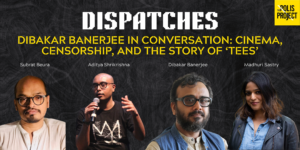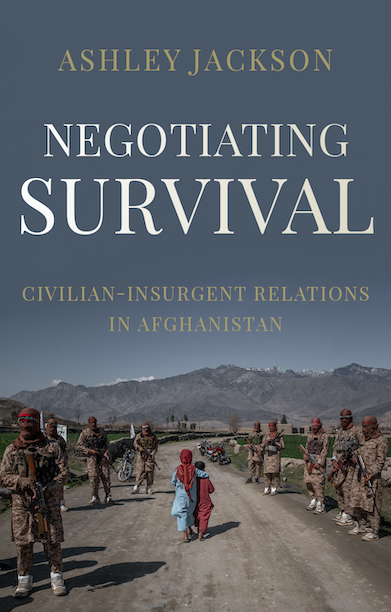

Excerpted from “Negotiating Survival: Civilian–Insurgent Relations in Afghanistan” by Ashley Jackson and published by C. Hurst & Co. (Publishers) Ltd. in the UK and Oxford University Press in USA © Ashley Jackson, 2021. Used by permission. All rights reserved. Footnotes have been removed to ease reading.
Negotiating for Survival
Both civilians and insurgents have been forced to negotiate with each other in order to survive. The Taliban bargains with civilians because they need a nominal level of compliance from the population. At the very least, they must ensure that civilians will not oppose, obstruct or threaten the insurgency. As the Taliban exert influence over a given territory, they must ensure that civilians will follow their rules. While the Taliban can, and often does, use violence and coercion, this is not sufficient in itself. They typically combine that coercion with incentives like the provision of security or protection of goods, services and economic opportunities.
Civilians have considerably less power to wield in these negotiations than insurgents. Indeed, some try to avoid the Taliban for as long as they can, or they fee for government-controlled areas. Few who remain in areas of Taliban influence, however, can keep themselves entirely apart from the insurgency for long. In civil wars, people are, by definition, the prize. Neutrality is nigh on impossible, but it’s more complicated than simply picking sides. For civilians, survival is often a question of simultaneously navigating the demands of both the government and insurgency. As the government and insurgency vied for dominance, large swathes of territory flip-flopped repeatedly between pro-government forces and the Taliban. Picking one side invites retaliation from the opposing side, and the conflict has been so long running and so deeply entrenched that few living through it believe there is an end in sight.
Commonly used terms and concepts in the study of civil wars, such as ‘collaboration’, ‘support’ or ‘taking sides’, betray a fundamental misunderstanding of the civilian–insurgent relationship. Listening to civilians themselves describe the situation, the disconnect is impossible to ignore. I remember interviewing a teacher who refused to express an opinion about Taliban rule, despite my best attempts to get him to do so. He kept insisting there were ‘no problems’ with the Taliban and that he merely did what was needed to keep the school running. Khairullah, a translator and research assistant helping me that day, was clearly amused by my ineffectual prodding. ‘You think people have a choice to take sides. He’s telling you that the Taliban does not allow there to be any “civilians,”’ he said. ‘Even if you do not fght with them, you must be on their side.’ I was not only asking a dangerous question in pushing the teacher to express a preference, but—worse yet—I had implied that he had much of a choice at all. Once we had all of this out in the open, the teacher was (perhaps unsurprisingly) less reticent to talk about just how complicated it was to run a government school under Taliban control.
The best (or perhaps least bad) course of action is for civilians to leverage what they can—compliance, social connections and so on—to their advantage in bargaining with insurgents. For this to work, they must be deliberate, strategic and creative. They must also be keen conflict analysts because their fate in part depends on how well they can understand and predict what combatants want, what the risks of engaging with them are and the overall dynamics of the war. As in Haji Aman’s case, civilians may leverage the promise of their collective compliance or issue subtle threats. They may craft persuasive arguments, which invoke the insurgency’s political objectives or ideals, or offer a quid pro quo. This could be intelligence in exchange for access to opportunities, or collective compliance in exchange for a greater degree of community protection.
Civilian–insurgent bargains might have been routine by the time I started my research for this book, but they varied enormously across space and time. Haji Aman was able to secure a deal with the Taliban on schools, but unable to do so on a number of other issues. Why did bargaining dynamics differ so significantly over time? And why have they varied so much across areas of Taliban influence or control, sometimes even differing in neighbouring villages or districts? The answer to this question does not point to a single factor or a straightforward explanation. The short answer is that civilian–insurgent bargaining— like any negotiation—is dynamic, bound by definition to vary according to a range of endogenous and exogenous factors. Negotiations are complex social processes, rooted in the specific context in which they occur and shaped by interpersonal dynamics. Broader conflict dynamics are equally important. Civil war is nothing if not volatile and fuid, and insurgent strategies and behaviour evolve in response to these shifting dynamics. The Taliban (much like any other insurgency) has behaved differently towards civilians when it is under intense military pressure than when it has had the battlefeld advantage. Haji Aman raised his requests many times with the Taliban, but his success was partly down to timing: the Taliban had by then assumed frm control of the area, and thus felt obligated to re-open schools (or, at the very least, they probably felt that it was in their interest to do so, now that they were the de facto governing authority).
Alongside this, the character of the insurgency and the ideology it espouses shape the conduct of fighters and their interactions with civilians. The nature and terrain of bargaining with an Islamist nationalist insurgency like the Taliban will likely be different to that of a Marxist or socialist insurgency. Here, understanding the degree to which an insurgency is coherent—meaning that it has relatively clear objectives shared up, down and across the movement, and its adherents are mostly able to act in a unified way to achieve those objectives—is essential. Coherence is often a by-product of maturity, so older insurgencies are more likely than very young ones to be able to bargain consistently and reliably with civilians. In Afghanistan, the Taliban’s interests, leverage and range of viable options have dramatically transformed since it emerged as an insurgency in 2002. But even across the terrain they influenced and controlled, the ways in which the Taliban bargains with civilians have varied.
One of the single most important factors influencing this variability is social capital. Those who write about or analyse conflict often talk about combatants and civilians as though they are completely distinct categories. This does not match the lived reality of civil war. Civilians and the Taliban are enmeshed in the same cultural, social and kinship fabric. That civilians are agents within the broader landscape of the conflict gives them leverage. Most people I interviewed knew the Taliban somehow. Some were related to an insurgent by blood or marriage, while some had gone to school with someone who later joined the insurgency. Many used these links, or other forms of common ground, to bargain.
Khairullah was a case in point. He was a university student by the time I met him, but he had acted as a lookout for the Taliban when he was younger and had many friends on both sides of the conflict. His brother was still with the Taliban, and he had many acquaintances on the Taliban side. Khairullah was a born networker, cultivating as many links as he could and using them to protect himself, to help friends and relatives negotiate with the Taliban and, indeed, to help me with the interviews for this book. After four decades of near-continuous armed conflict, many felt that relationships, perhaps above all else, were integral to their survival.
Another problem with the way we talk about civilians is that we tend to lump them all together by default. We define the term ‘civilian’ as essentially anyone who isn’t bearing arms or actively fghting on one side or another, and we disregard the fact that many of them may actually have very little in common beyond this. Instead of talking about civilians as one undifferentiated mass, this book seeks to break them down into three ideal categories, defined by the interests that drive them to engage with the insurgency, and by the power they possess. This way of breaking them down is purely functional, and admittedly imperfect, but it helps to illuminate different patterns of civilian behaviour vis-à-vis the Taliban.
This is elaborated further in Chapter 3, but of the three civilian ‘types’ this book examines, the first is customary authorities, comprising elders like Aman, as well as village leaders and religious officials. They typically negotiate group interests, meaning that their greatest leverage with the Taliban is that they can deliver—or withhold—the collective compliance of the communities they represent. The second is private organisations, denoting any organised entity, from NGOs and charities to farming associations to international companies. They tend to negotiate in pursuit of their organisational interests, and their greatest leverage is the incentives they can offer (i.e., aid projects, financial payments, services, jobs or other economic opportunities). The final category is the most unwieldy: individuals, or those negotiating with the Taliban on their own behalf, usually in pursuit of survival or other interests. Social position and social capital, which may endow one person with enormous power by virtue of the family or tribe they are born into, are again critical. But so too are less tangible, more individualised (and incidentally less theorisable) qualities like appetite for risk and networking skills.





